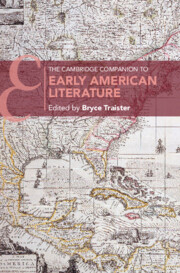Book contents
- The Cambridge Companion to Early American Literature
- The Cambridge Companion to Early American Literature
- Copyright page
- Contents
- Figures
- Contributors
- Introduction
- Part I How to Read (in) Early America
- 1 How to Read Things That Weren’t Written Down in Early America
- 2 How to Read the Natural World
- 3 How to Read Early American Poetry
- 4 How to Read Gender in Early America
- 5 How to Read an Early American Novel
- 6 How to Read Democracy in the Early United States
- Part II Readings in Early America
- Part III Early American Places
- Select Bibliography
- Index
- Cambridge Companions To …
4 - How to Read Gender in Early America
from Part I - How to Read (in) Early America
Published online by Cambridge University Press: 18 November 2021
- The Cambridge Companion to Early American Literature
- The Cambridge Companion to Early American Literature
- Copyright page
- Contents
- Figures
- Contributors
- Introduction
- Part I How to Read (in) Early America
- 1 How to Read Things That Weren’t Written Down in Early America
- 2 How to Read the Natural World
- 3 How to Read Early American Poetry
- 4 How to Read Gender in Early America
- 5 How to Read an Early American Novel
- 6 How to Read Democracy in the Early United States
- Part II Readings in Early America
- Part III Early American Places
- Select Bibliography
- Index
- Cambridge Companions To …
Summary
If one of the most prominent features of early America was the collision of peoples from two hemispheres, much of this collision found expression through different expectations of how men and women should behave. Because participants in these encounters saw that what they thought of as natural attributes of men and women were not consistent across the lines of culture, and because printed descriptions of those encounters expanded the audience for those encounters, it is not an exaggeration to say that early America as a site of contact did much to provoke widespread contemplation of what in the twentieth century came to be known as the distinction between sex and gender. Texts such as John Marrant’s account of his captivity in a Cherokee town and Amerigo Vespucci’s letters illustrate how understanding early America in all its complexity requires accounting for the intricacies of gender as they were performed in intersection with other identity categories such as race. The history of colonialism and the Atlantic slave trade also shows how gender became an instrument of domination. Finally, the stories of figures like Catherine Tekakwitha demonstrate that occasionally individuals found new lives in early America in part by adopting foreign performances of gender.
- Type
- Chapter
- Information
- The Cambridge Companion to Early American Literature , pp. 68 - 82Publisher: Cambridge University PressPrint publication year: 2021



